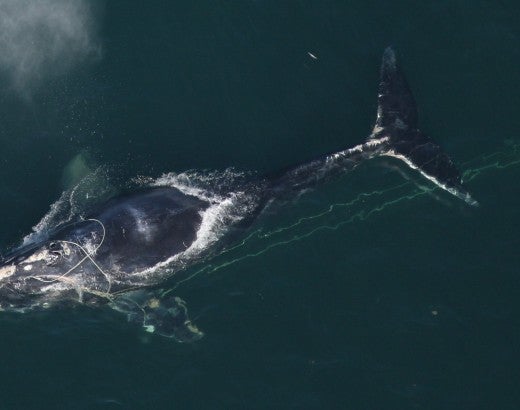North Atlantic right whales are among the most critically endangered animals on the planet today. There are fewer than 440 left on earth, and their mortality rates are high: at least 20 individual right whales died in U.S. and Canadian waters during 2017 and 2018 and no calves were born during this period. Scientists estimate that at this rate, right whales could become extinct in 20 years.
Causes of right whale mortality are manmade and preventable. They include ship strikes, habitat destruction and entanglement in fishing gear, and we believe it is within the power of the United States and Canada -- the countries whose eastern shores are home to these animals -- to reverse the tide driving these whales toward extinction before it’s too late.
Canada, particularly, has an important role to play because as right whales meander along the Atlantic seaboard during seasonal migrations, they are now spending more time in Canadian waters, likely because of shifting distribution of their prey.
That’s why today, along with a coalition of wildlife and animal protection groups, the Humane Society of the United States and Humane Society International sent a letter to Canada calling on its Department of Fisheries and Oceans (DFO) to close more risk-prone fisheries during months of high use in order to protect right whales from dying after getting entangled in fishing gear.
Last year, Canada took much-needed action by closing several fishing areas in the Gulf of St. Lawrence to reduce the risk of right whales getting entangled in fishing gear, and we commend these measures. The DFO is now reviewing these entanglement risk reduction measures to determine steps to take in 2019.
The suffering these animals endure once they are entangled in fishing gear is immense: the whales can drown and die immediately, or they could remain entangled and injured and die a slow, prolonged death, with the ropes cutting into their flesh for days, weeks, months, and in some cases, years, causing agonizing pain or preventing them from eating. Death results from injuries, infections or starvation. Female whales are particularly susceptible to getting entangled in fishing gear.
Reducing and eliminating threats to the North Atlantic right whale has long been a focus for us at the HSUS and HSI and we have won several domestic victories. In 2013, as the result of a legal petition filed by the HSUS, the United States mandated that large ships slow down while passing through right whale habitat. This has resulted in reduced deaths from lethal ship strikes. We also successfully petitioned to expand their designated critical habitat protections in key feeding areas and in the Southeastern United States where females birth their young.
We continue fighting for other protections here, and earlier this year the HSUS, along with a coalition of groups, filed suit against the National Marine Fisheries Service for failing to meet its legal mandates to prevent right whales from becoming ensnared by commercial fishing gear and lobster trap lines. In Congress, U.S. Senators Cory Booker, D-N.J., Tom Carper, D-Del., Bill Nelson, D-Fla., Bob Menendez, D-N.J. and Kirsten Gillibrand, D-N.Y., as well as U.S. Representatives Seth Moulton , D-Mass., Raul Grijalva, D-Ariz., Jared Huffman, D-Calif., and William Keating, D-Mass., have introduced The SAVE Right Whales Act of 2018, S. 3038 and H.R. 6060, to establish a grant program across stakeholders to fund collaborative solutions to protect North Atlantic right whales.
But time is running out, that's why it's so crucial for Canada and the United States to expand protections. Right whales were so named because they were a favorite target for whalers: they followed the coastline, moved slowly, and floated when they were dead, so were considered the “right” whale to kill. Fortunately, most of the world has moved on from such thinking. It is time that we right the wrongs of the past – and correct the mistakes we are making now – to keep yet another majestic species from going extinct.



